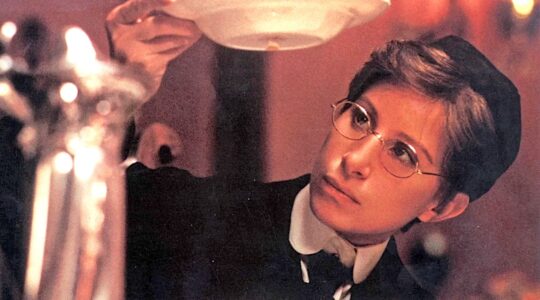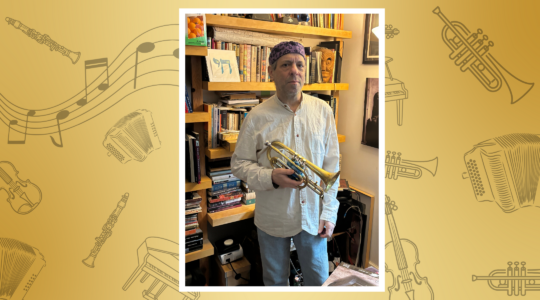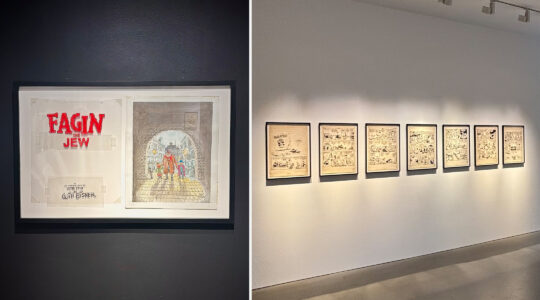Over the past decade, Gaga — the movement language, not the Lady — has become one of Israel’s key cultural exports. Developed by acclaimed choreographer Ohad Naharin, artistic director of Israel’s Batsheva modern dance troupe, it has spread far beyond its original role as a dance technique, becoming a tool for self-discovery for anyone with a body and the curiosity to use it. Today, Gaga classes are held in large cities from New York to Tokyo; enthusiasts envision it as tomorrow’s yoga.
But what exactly is Gaga? Even practitioners struggle to get their hands around a definition.
“For those who are unfamiliar, I sometimes describe it as a meditation, a dance party, down time at the pool, a really extreme workout and a moment to yourself to just let loose, all mashed up into a one-hour class,” Omri Drumlevich, Gaga teacher and former Batsheva dancer, explained in a recent phone interview. “I can use a lot of words to describe it, but if you want to really know what Gaga is, you need to experience it.”
Last Wednesday was Gaga night in Central Park. The SummerStage event featured a short, Gaga-centric dance piece by the Brooklyn-based modern dance troupe Gallim, led by former Batsheva member Andrea Miller, followed by a screening of “Mr. Gaga,” Tomer Heymann’s documentary about Naharin’s life and artistic process. But perhaps the most coveted part of the evening was the pre-show Gaga workshop, led by Drumlevich, which sold out within days of the event going online. “It’s not fair, I tried to RSVP like the second it went up and it was already booked,” Shlomit Dinan, a 23-year-old aspiring Israeli dancer, complained to the SummerStage staff. No luck; they wouldn’t let her in.
Onstage, behind the security barriers, around 30 lucky attendees were gyrating and writhing to Drumlevich’s idiosyncratic instructions. “You are moving as if you are inside water … and now it is thickening into honey,” he directed. Even as the imaginary liquid atmosphere became denser, increasing the muscle tension needed to push through it, participants were urged to move faster. As the momentum built, bodies began quivering in effort, some spontaneously seizing. There was no premeditated choreography, but the scene took on a Batsheva-esque look.
Gaga, Drumlevich explained over the phone, “is a movement language and practice that is based on physical, multilayered tasks meant to improve physical skills and ability, flexibility and stamina,” as well as hone a sensitivity to the nuances of movement. With more emphasis on how a movement feels like than how it looks, instructions are given in terms of sensory metaphors, such as “float” or “make your flesh thicker.”
“People receive a literal task, such as ‘let’s fold and unfold our body parts,’” Drumlevich continued. “Another layer may be ‘make your flesh thicker.’ Then, the instructor might ask the participants to ‘connect to the feeling of inflating and deflating their body,’ adding a dimension of pleasure and enjoyment from the movement. The metaphors feed the mental and spiritual fulfillment of the task. There are a lot of different components that make up movement — speed, size, effort; in Gaga you take the most simple way to describe it and experience it, but also you are not shy to go into the depth and explore every component and how you can enhance it with more pleasure, or more sensation.”
While many aspects of Gaga vary from teacher to teacher, some are constants. In every Gaga class, all participants must sweat, remain in constant movement (between tasks they “float,” imagining their bodies immersed) and carry out tasks based on sensory input from their bodies. Pre-mandated goals, or even thinking in general, are frowned upon. No mirrors and no spectators are allowed.
Naharin created Gaga over 20 years ago after suffering from nerve damage that limited his own ability to dance. “I had to teach myself to move in a new way … within my limitations,” Naharin recounts in “Mr. Gaga.” The movement language also grew out of Naharin’s difficulty communicating the exact emotional nuances he was seeking to his dancers. “In rehearsals … there was always yelling and someone was always crying,” one dancer recalled of the pre-Gaga days. The technique helped the dancers get a better understanding of what Naharin wanted, and the choreographic process became more of a two-way street. “I used to think there are two separate layers to the work — how the choreographer creates it, and how the dancer interprets his creation,” Naharin said. “Now they are one and the same for me.”
Back at the Gaga class, Drumlevich built up the physical and emotional intensity, with a good measure of silliness for balance. The class culminated in a Middle Eastern-flavored dance party. People left subtly altered. Most were hugging and laughing; a couple dabbed away tears. On their way out, the Gaga-niks were asked how they felt. One participant replied, “different than I was”; another, “more like myself.”
The New York Jewish Week brings you the stories behind the headlines, keeping you connected to Jewish life in New York. Help sustain the reporting you trust by donating today.




